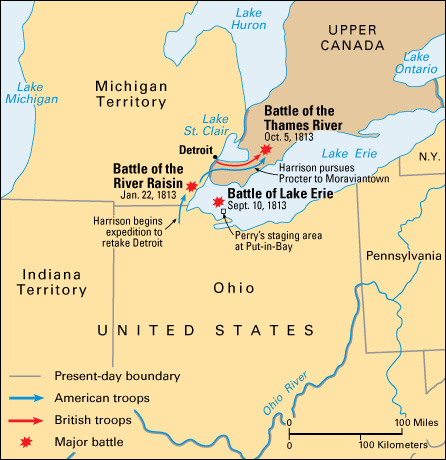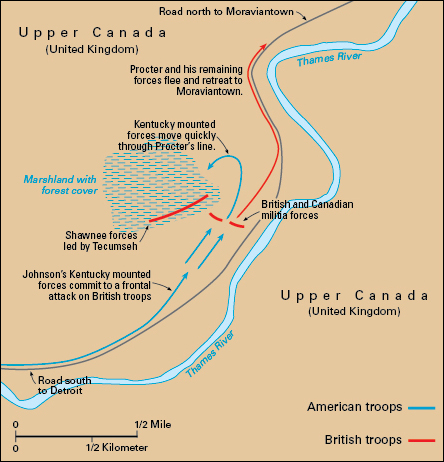Thames River, Battle of the, was an important American victory in the War of 1812 (1812-1815). The battle took place in October 1813 along the Thames River in what is now Ontario, Canada. United States Major General William Henry Harrison led the American Army of the North West against a combined British and Indian force. British soldiers under Brigadier General Henry Procter (also spelled Proctor) fled early in the battle. However, Indian forces held their ground and suffered heavy losses. Their leader, Tecumseh, died on the battlefield. The Battle of the Thames River is sometimes called the Battle of Moraviantown, after a town near the battlefield.

Background.
British and Indian forces, led by General Procter and Tecumseh, attacked American forts in Ohio during the spring and summer of 1813. But in September, an American naval force led by Master Commandant Oliver Hazard Perry defeated a British fleet on Lake Erie. Perry’s victory gave the Americans control of the lake. It also forced the British to pull out of Detroit, near Lake Erie, and return to the British colony of Upper Canada.
More than 800 retreating British troops were joined by 500 Indians under Tecumseh. General Harrison’s American force had about 5,500 men, including a large number of Kentucky volunteers (citizen soldiers). Harrison’s army crossed Lake Erie. He left troops to defend Detroit and other places the British had abandoned. For the next several days, Harrison led 3,500 Americans in pursuit of Procter’s British force. Along the way, the Americans picked up discarded British supplies, including two gunboats full of ammunition.

The battle.
On October 5, the British halted near Moraviantown, on the Thames River in what is now Kent County, Ontario. They prepared for battle against the advancing Americans.

Shouting “Remember the Raisin,” Kentucky mounted riflemen under the command of Kentucky Colonel Richard M. Johnson, a U.S. congressman, charged forward and pierced the British line. The battle cry referred to the River Raisin Massacre, in which Indian warriors had killed wounded American prisoners. Johnson’s maneuver trapped the British in a crossfire, and many soldiers surrendered. Procter and many of his men fled soon after the first volley. Tecumseh and his Shawnee warriors, however, stayed to face their enemy. Tecumseh was soon shot and killed, and many Indians abandoned the battlefield.
In the course of the battle, 12 British troops and 33 Indians were killed. Twenty-two British troops were wounded, and about 600 were captured. For the Americans, 7 were killed and 22 were wounded.
Aftermath.
The death of Tecumseh broke the league of Indian tribes that had been allied to the British. Kentuckians celebrated their fellow citizens’ victory over enemies responsible for the January 1813 massacre on the River Raisin. A military court in Quebec sentenced Procter to be publicly reprimanded for his conduct during the war. Colonel Johnson won fame for reportedly firing the shot that killed Tecumseh. He went on to serve as vice president of the United States from 1837 to 1841. General Harrison became president in 1841 but died after just 30 days in office.
See also Harrison, William Henry ; Johnson, Richard Mentor ; Lake Erie, Battle of ; River Raisin, Battle of the ; Tecumseh ; War of 1812 .
